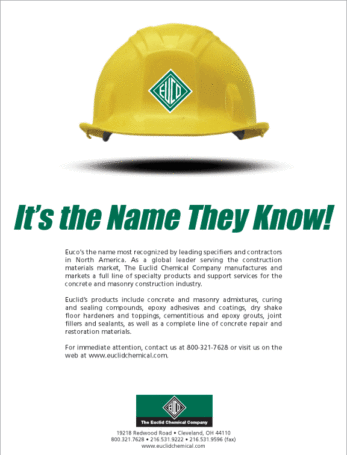09 Jun October 2016 Newsletter
The cooler autumn weather is finally upon us after a long, hot, dry summer, at least in most parts of the South. The impending presidential election doesn’t appear to have had much effect on construction although I have heard some forecasters say that some developers have put projects on hold until they see who will be our next president. This may be the case but we certainly haven’t experienced it.

Dear Friends,
The cooler autumn weather is finally upon us after a long, hot, dry summer, at least in most parts of the South. The impending presidential election doesn’t appear to have had much effect on construction although I have heard some forecasters say that some developers have put projects on hold until they see who will be our next president. This may be the case but we certainly haven’t experienced it. We continue to be wide open.
The rash of price increases we reported on last month has abated and a more detailed analysis of pricing for the key products we sell follows below:
- Unlike September, few manufacturers of construction products we distribute increased prices in October or announced price increases. Scrap steel prices in the US were flat in October, however; scrap steel and billet prices moved up on foreign exchanges due to increased demand by foreign mills, which may cause prices for imported construction steel products to increase in early 2017.
- Prices for domestic and imported rebar were unchanged from September. With the price for scrap steel being unchanged on US metal exchanges in October, most analysts think that domestic mills will hold their current prices through the end of the year. Imported rebar prices should also be unchanged for the remainder of the year, but some analysts are now speculating that imported rebar prices will increase in early 2017 if demand continues to increase in the coming months.
- Resin manufactures were unable to push through another price increase in October after increasing prices by $.04/LB in September. As resin prices did not increase in October, polyethylene sheeting manufacturers will not implement a price increase in November as they had previously announced. Resin manufacturers have announced a price increase of $.05/LB for November. If the resin increase sticks, expect polyethylene sheeting manufacturers to increase prices by early December.
- Prices for southern yellow pine dimensional lumber began to move up in late September and have risen each week in October, due to a spike in demand and are now $20 to $40 more per MBF than they were in September. Lead times for truckloads are now approximately 2 weeks instead of the normal 1 week lead time. Most analysts expect demand to weaken in November and for prices to begin moving down by mid-November.
- Concrete reinforcing wire mesh prices have remained basically flat for the past few months and are expected to remain at current levels through November, and probably through December, as demand has been less than anticipated this fall.
- With the industry wide Portland cement price increase in January, several concrete block, concrete lintel, and pre-cast concrete manufacturers have announced a January price increase. Please ensure that you get a quote for these items before bidding any projects that will start next year.
- Carlisle Coatings & Waterproofing announced on October 6th that they will increase prices on R2+ Insulations by 5% on January 1st and will not offer any price protection for orders shipped on or after January 1st. If you are bidding any projects which specify R2+ Insulation that will not ship this year, be sure to get a quote from your sale representative.
- The PPI for final demand in September, not seasonally adjusted, increased 0.2% from August and 0.7% year-over-year (y/y) from September 2015, the Bureau of Labor Statistics (BLS) reported on October 14. AGC posted tables and an explanation focusing on construction prices and costs.
- Dodge Data & Analytics released its 2017 construction outlook on October 20, forecasting that “total U.S. construction starts for 2017 will advance 5%…, following gains of 11% in 2015 and an estimated 1% in 2016. [Chief economist Robert Murray stated,] ‘the construction industry has now entered a more mature phase of its expansion, one that is characterized by slower rates of growth than [during 2012-2015], but still growth. Since the construction start statistics will lead [spending], spending can be expected to see moderate gains through 2017 and beyond….Gains of 8% are expected for both residential…and nonresidential building, while non-building construction slides a further 3%.’
Click here for the latest update on the construction economy from Ken Simonson, the chief economist of the AGC.
SPECCHEM
Quality construction chemicals for the concrete industry

EUCLID
Maker of chemicals and aggregates for the concrete industry

ACCESS TILE
The ultimate solution in detectable warning systems
Access Tile is the result of responding to a market demand for a better solution to detectable warning tiles at a cost-effective price. With over 20 years of proven manufacturing experience in detectable warnings, Access Tile’s improved design features will exceed industry expectations from specifier to installer.




AJ Mozingo
This month we spotlight AJ Mozingo, Operations Manager at our Garner (Raleigh) branch. AJ was born in Johnston County, North Carolina and graduated from South Johnston High School. He attends Northcentral Technical College where he is working on a business management degree. He and his wife, Claudia, have one son, Ryder, who is two years old. AJ is a big Carolina Panthers and NC State football fan. Aside from football he likes go to NASCAR races and spending time with his family. Prior to joining us he was with Carolina Form and Scaffold Supply as operations manager and was a Rebar Fabrication Supervisor at M&N Construction Supply. Adding AJ to our team has definitely helped our rebar fabrication capabilities in Raleigh. If you need any rebar fabricated in the Raleigh area, be sure to give AJ call.
Our management article this month is, How to Get People to Listen When You Speak. Some managers, especially new ones have a hard time getting the people who report to them to listen when they speak. This article has several great tips on how to command attention when you speak.
OCTOBER’S MANAGEMENT ARTICLE
How to Get People to Listen When You Speak
By Gwen Moran
In meetings, emails, conversations, and conference calls, business leaders spend roughly 80% of their time communicating. So, it’s a significant waste of time and resources if that communication isn’t effective. When it comes to the way we speak to others—either groups or individuals—we can often be inadvertently doing or saying things that undermine our effectiveness.
There’s a fine line between being warm and engaging and making listeners feel intimidated or threatened.
American English is typically spoken at roughly 183 words per minute, but we can listen and understand at up to 400 words per minute. The difference can lead to distraction, says speech coach Ethan F. Becker, PhD, president of the Speech Improvement Company, a speech and communications coaching firm, and author of Mastering Communication at Work: How to Lead, Manage and Influence. “There are all sorts of conversations in the back of our mind,” he says. “When I add filler words or something like that, I increase the chance of miscommunication.”
Are you doing or saying things that make people tune out or distract them from your message? Here are eight common habits to avoid.
1. Dismissing Their Message
Common phrases like, “You think that’s bad? Listen to this!” could be intended to communicate a shared experience, but actually sounds dismissive of the other person’s message or experience, Becker says. That can be off-putting. Suddenly your conversation partner or audience is put in defensive mode rather than listening to your experience. It’s better to affirm that you heard the other person’s story or experience and state that you can relate because you’ve been through something similar, then tell your story, he says. Using the word “but” can have a similar effect.
2. Using Too Many Filler Words
Words like “um,” “you know,” or “like,” are filler words—Becker calls them “vocalized pauses”—that we tend to repeat out of habit or because of nervousness. Research his team at the Speech Improvement Company has done found that while a few instances per minute doesn’t typically deter the message, upwards of six per minute becomes increasingly distracting and makes it difficult for the listener to focus on what you have to say.
3. Breaking Out The Jargon
It’s important to not be condescending to your audience, but even if you’re in a room full of people who are fluent in industry jargon, they don’t want to hear people speak that way for too long, says Kory Floyd, PhD, professor of communication at the University of Arizona and author of Communication Matters.
Failing to allow appropriate interaction can leave your audience members feeling like you don’t care.
Using too much technical language, “or even $5 words when a 50¢ word will do,” makes language more complicated than it needs to be, says Floyd. Being accessible and specific in your language doesn’t mean “dumbing it down.” You’re simply making it easier for people to truly understand what you’re saying, he says.
4. Pretending To Be Someone You’re Not
Similarly, the first rule of great communication is to understand your own style, strengths, and weaknesses and adapt to them. Trying to be overly formal when that’s not really who you are can sound inauthentic and make listeners less likely to hear your message.
5. Speaking In A Monotone
When you speak in the same tone throughout the conversation or presentation, you risk losing your audience, Becker says. It’s important to change your speaking patterns, especially when you’re speaking to groups, he says. Moving from an animated, fast-paced speech pattern to one that’s more leisurely and relaxed can help keep your audience engaged. If they hear too much of the same speech pattern, they may “zone out,” because monotonous speech patterns can be boring, he says.
6. Failing To Regulate Personal Space
A well-known Seinfeld episode put the term “close talker”—someone who moves in close, especially face-to-face, when speaking to another person—into the common lexicon. In interpersonal communication, ensuring proper personal space is essential, says communication expert Leil Lowndes, author of How to Talk to Anyone: 92 Little Tricks for Big Success in Relationships.
But it’s not as simple as it seems. If someone moves in close and you pull back abruptly, you could inadvertently send the signal that you’re not open to what they have to say. At the same time, if the person is making you uncomfortable, you need to adjust your distance so that you can effectively speak. Sometimes, getting interpersonal space right is like “a little dance,” she says, but take your cues from your counterpart and your own comfort level.
7. Getting Eye Contact Wrong
It’s well-known that eye contact is important in interpersonal communication, but there’s a fine line between being warm and engaging and making listeners feel intimidated or threatened, Becker says.
Communications-analytics company Quantified Communications found that adults make eye contact between 30% and 60% of the time while speaking to individuals or groups, yet they should make eye contact roughly 60% to 70% of the time.
Becker says that when you’re speaking to a group, it’s important to vary eye contact around the room. Common advice to speakers is to pick more than two or three faces to avoid making those few people very uncomfortable, he says.
8. Ignoring Interaction
Whether you’re speaking to a person or a group, failing to allow appropriate interaction can leave your audience members feeling like you don’t care about their feedback, Floyd says. These exchanges are supposed to have give-and-take, he points out. When there’s no opportunity to participate, listeners may lose interest.
In closing, I don’t know about you, but I am more than ready for this presidential campaign season to end and I hope that the outcome will not have negative impact on the construction industry. Enjoy the fall building season and let’s hope that we finish the year on a high note.
Best regards,

Jim Sobeck
President 864-263-4377
jim.sobeck@newsouthsupply.com
Connect with us: Twitter | YouTube | Facebook | LinkedIn
Author of The Real Business 101: Lessons From the Trenches
Get your copy below.
For Smashwords (eBook version for Kindle, iPad, Nook) click here
For direct link to Amazon site (Kindle and print version) click here

No Comments